Enhanced Flame Retardancy in Ethylene–Vinyl Acetate Copolymer/Magnesium Hydroxide/Polycarbosilane Blends
Abstract
:1. Introduction
2. Materials and Methods
2.1. Materials
2.2. Preparation of Composites
2.3. Characterization
3. Results and Discussion
3.1. Microstructure of the Composites
3.2. Flammability
3.3. Combustion Behaviours
3.4. TG–TFIR Analysis
3.5. Identification of Pyrolyzates by Py–GC/MS
3.6. Morphology of the Char
3.7. Mechanistic Analysis
4. Conclusions
Author Contributions
Funding
Conflicts of Interest
References
- Dearmitt, C. New ATH developments drive flame retardants cable compounding. Plast. Add. Compd. 2002, 4, 12–14. [Google Scholar] [CrossRef]
- Hettal, S.; Roland, S.; Sipila, K.; Joki, H.; Colin, X. A new analytical model for predicting the radio-thermal oxidation kinetics and the lifetime of electric cable insulation in nuclear power plants. Application to silane cross-linked polyethylene. Polym. Degrad. Stab. 2021, 185, 109492. [Google Scholar] [CrossRef]
- Laoutid, F.; Gaudon, P.; Taulemesse, J.-M.; Lopez Cuesta, J.M.; Velasco, J.I.; Piechaczyk, A. Study of hydromagnesite and magnesium hydroxide based fire retardant systems for ethylene-vinyl acetate containing organo-modified montmorillonite. Polym. Degrad. Stab. 2006, 91, 3074–3082. [Google Scholar] [CrossRef]
- Rothon, R.N.; Hornsby, P.R. Flame retardant effects of magnesium hydroxide. Polym. Degrad. Stab. 1996, 54, 383–385. [Google Scholar] [CrossRef]
- Ngohang, F.E.; Fontaine, G.; Gay, L.; Bourbigot, S. Smoke composition using MLC/FTIR/ELPI: Application to flame retarded ethylene vinyl acetate. Polym. Degrad. Stab. 2015, 115, 89–109. [Google Scholar] [CrossRef]
- Camino, G.; Maffezzoli, A.; Braglia, M.; De Lazzaro, M.; Zammarano, M. Effect of hydroxides and hydroxycarbonate structure on fire retardant effectiveness and mechanical properties in ethylene-vinyl acetate copolymer. Polym. Degrad. Stab. 2001, 74, 457–464. [Google Scholar] [CrossRef]
- Laoutid, F.; Lorgouilloux, M.; Lesueur, D.; Bonnaud, L.; Dubois, P. Calcium-based hydrated minerals: Promising halogen-free flame retardant and fire resistant additives for polyethylene and ethylene vinyl acetate copolymers. Polym. Degrad. Stab. 2013, 98, 1617–1625. [Google Scholar] [CrossRef]
- Yeh, J.T.; Yang, M.J.; Hsieh, S.H. Combustion of polyethylenes filled with metallic hydroxides and ethylene vinyl acetate copolymer. Polym. Degrad. Stab. 1998, 61, 65–472. [Google Scholar] [CrossRef]
- Lan, S.J.; Li, L.J.; Xu, D.F.; Zhu, D.H.; Liu, Z.Q.; Nie, F. Surface modification of magnesium hydroxide using vinyltriethoxysilane by dry process. Appl. Surf. Sci. 2016, 382, 56–62. [Google Scholar] [CrossRef]
- Patti, A.; Lecocq, H.; Serghei, A.; Acierno, D.; Cassagnau, P. The universal usefulness of stearic acid as surface modifier: Applications to the polymer formulations and composite processing. J. Ind. Eng. Chem. 2021, 96, 1–33. [Google Scholar] [CrossRef]
- Zhang, S.; Bu, X.X.; Gu, X.Y.; Sun, J.; Li, H.F.; Tang, W.F. Improving the mechanical properties and flame retardancy of ethylene-vinyl acetate copolymer by introducing bis [3-(triethoxysilyl) propyl] tetrasulfide modified magnesium hydroxide. Surf. Interface Anal. 2016, 49, 607–614. [Google Scholar] [CrossRef]
- Yao, D.W.; Yin, G.Z.; Bi, Q.Q.; Yin, X.; Wang, N.; Wang, D.Y. Basalt Fiber Modified Ethylene Vinyl Acetate/Magnesium Hydroxide Composites with Balanced Flame Retardancy and Improved Mechanical Properties. Polymers 2020, 12, 2107. [Google Scholar] [CrossRef]
- Hippi, U.; Mattila, J.; Korhonen, M.; Seppälä, J. Compatibilization of polyethylene/aluminum hydroxide (PE/ATH) and polyethylene/magnesium hydroxide (PE/MH) composites with functionalized polyethylenes. Polymer 2003, 44, 1193–1201. [Google Scholar] [CrossRef]
- Sonnier, R.; Viretto, A.; Dumazert, L.; Longerey, M.; Buonomo, S.; Gallard, B.; Longuet, C.; Cavodeau, F.; Lamy, R.; Freitag, A. Fire retardant benefits of combining aluminum hydroxide and silica in ethylene-vinyl acetate copolymer (EVA). Polym. Degrad. Stab. 2016, 128, 228–236. [Google Scholar] [CrossRef]
- Guo, Y.C.; Xue, Y.; Zuo, X.H.; Zhang, L.X.; Yang, Z.H.; Zhou, Y.C.; Marmorat, C.; He, S.; Rafailovich, M. Capitalizing on the molybdenum disulfide/graphene synergy to produce mechanical enhanced flame retardant ethylene-vinyl acetate composites with low aluminum hydroxide loading. Polym. Degrad. Stab. 2017, 144, 155–166. [Google Scholar] [CrossRef]
- Wang, C.H.; Wang, J.H.; Men, Z.L.; Wang, Y.L.; Han, Z.D. Thermal Degradation and Combustion Behaviours of Polyethylene/Alumina Trihydrate/Graphene Nanoplatelets. Polymers 2019, 11, 772. [Google Scholar] [CrossRef] [Green Version]
- Han, Z.D.; Wang, Y.L.; Dong, W.Z.; Wang, P. Enhanced fire retardancy of polyethylene/alumina trihydrate composites by graphene nanoplatelets. Mater. Lett. 2014, 128, 275–278. [Google Scholar] [CrossRef]
- Ye, L.; Wu, Q.H.; Qu, B. Synergistic effects and mechanism of multiwalled carbon nanotubes with magnesium hydroxide in halogen-free flame retardant EVA/MH/MWNT nanocomposites. Polym. Degrad. Stab. 2009, 94, 751–756. [Google Scholar] [CrossRef]
- Szép, A.; Szabó, A.; Tóth, N.; Anna, P.; Marosi, G. Role of montmorillonite in flame retardancy of ethylene-vinyl acetate copolymer. Polym. Degrad. Stab. 2006, 91, 593–599. [Google Scholar] [CrossRef]
- Liu, L.; Hu, J.; Zhuo, J.L.; Jiao, C.M.; Chen, X.L.; Li, S.X. Synergistic flame retardant effects between hollow glass microspheres and magnesium hydroxide in ethylene-vinyl acetate composites. Polym. Degrad. Stab. 2014, 104, 87–94. [Google Scholar] [CrossRef]
- Hoffendahl, C.; Fontaine, G.; Duquesne, S.; Taschner, F.; Mezger, M.; Bourbigot, S. The combination of aluminum trihydroxide (ATH) and melamine borate (MB) as fire retardant additives for elastomeric ethylene vinyl acetate (EVA). Polym. Degrad. Stab. 2015, 115, 77–88. [Google Scholar] [CrossRef]
- Carpentier, F.; Bourbigot, S.; Le Bras, M.; Delobel, R.; Foulon, M. Charring of fire retarded ethylene vinyl acetate copolymer-magnesium hydroxide/zinc borate formulations. Polym. Degrad. Stab. 2000, 69, 83–92. [Google Scholar] [CrossRef]
- Lv, J.P.; Liu, W.H. Flame retardancy and mechanical properties of EVA nanocomposites based on magnesium hydroxide nanoparticles/microcapsulated red phosphorus. J. Appl. Polym. Sci. 2007, 105, 333–340. [Google Scholar] [CrossRef]
- Han, Z.D.; Fina, A.; Camino, G. Organosilicon Compounds as Polymer Fire Retardants. In Polymer Green Flame Retardants; Elsevier: Amsterdam, The Netherlands, 2014; pp. 389–418. [Google Scholar]
- Meng, W.H.; Wu, H.J.; Wu, R.F.; Wang, T.; Wang, A.Q.; Ma, J.; Xu, J.Z.; Qu, H.Q. Fabrication of surface-modified magnesium hydroxide using Ni2+ chelation method and layer-by-layer assembly strategy: Improving the flame retardancy and smoke suppression properties of ethylene-vinyl acetate. Colloids Surf. A Physicochem. Eng. Asp. 2021, 610, 125712. [Google Scholar] [CrossRef]
- Wang, C.F.; Wang, Y.L.; Han, Z.D. Enhanced flame retardancy of polyethylene/magnesium hydroxide with polycarbosilane. Sci. Rep. 2018, 8, 14494. [Google Scholar] [CrossRef]
- Wang, C.F.; Liu, J.W.; Wang, Y.L.; Han, Z.D. Enhanced flame retardance in polyethylene/magnesium hydroxide/polycarbosilane blends. Mater. Chem. Phys. 2020, 253, 123373. [Google Scholar] [CrossRef]
- Mark, H.F.; Bikales, N.M. Encyclopedia of Polymer Science and Technology, 3rd ed.; John Wiley & Sons, Inc.: Hoboken, NJ, USA, 2004; Volume 7, pp. 426–438. [Google Scholar]
- Petrella, R.V. The Assessment of Full-Scale Fire Hazards from CONE Calorimeter Data. J. Fire Sci. 1994, 12, 14–43. [Google Scholar] [CrossRef]
- Hirschler, M.M. How to Measure Smoke Obscuration in a Manner Relevant to Fire Hazard Assessment: Use of Heat Release Calorimetry Test Equipment. J. Fire Sci. 1991, 9, 183–222. [Google Scholar] [CrossRef]
- Shu, Z.J.; Xu, X.N.; Yang, S.S.; Wang, Y. Integrated Assessing Fire Hazard of Polymer Basedon Data of Cone Calorimeter. Chin. Polym. Bull. 2006, 5, 37–44. [Google Scholar]
- Yajima, S.; Hasegawa, Y.; Hayashi, J.; Iimura, M. Synthesis of Continuous Silicon Carbide Fibre with High Tensile Strength and High Young’s Modulus. J. Mater. Sci. 1978, 13, 2569–2576. [Google Scholar]
- Yao, R.Q.; Feng, Z.D.; Zhang, B.J.; Zhao, H.R.; Yu, Y.X.; Chen, L.F.; Zhang, Y. Blue photoluminescence from continuous freestanding β-SiC/SiOxCy/Cfree nanocomposite films with polycarbosilane (PCS) precursor. Opt. Mater. 2011, 33, 635–642. [Google Scholar] [CrossRef]
- Hasegawa, Y.; Okamura, K. Synthesis of continuous silicon carbide fibre part 4. The structure of polycarbosilane as the precursor. J. Mater. Sci. 1986, 21, 321–328. [Google Scholar] [CrossRef]
- Lanka, S.T.; Moses, N.G.A.; Suppiah, R.R.; Maulianda, B.T. Physio-chemical interaction of Ethylene-Vinyl Acetate copolymer on bonding ability in the cementing material used for oil and gas well. Pet. Res. 2021, in press. [Google Scholar] [CrossRef]
- Nair, S.G.; Siva, M.S.; Thomas, D.; Sreejith, K.J.; Prabhakaran, P.V.; Devasia, R. Liquid polycarbosilane as a potential chemical liquid vapour deposition precursor for SiC. Ceram. Int. 2019, 45, 17442–17446. [Google Scholar] [CrossRef]
- Delfosse, L.; Baillet, C. Combustion of ethylene-vinyl acetate copolymer filled with aluminium and Materials Chemistry and Physics magnesium hydroxides. Polym. Degrad. Stab. 1989, 23, 337–347. [Google Scholar] [CrossRef]
- Key, T.S.; Patel, D.K.; Wilks, G.B.; Cinibulk, M.K. Modeling the Pyrolysis of Preceramic Polymers: A Kinetic Study of the Polycarbosilane SMP-10. J. Eur. Ceram. Soc. 2021, 41, 6356–6365. [Google Scholar] [CrossRef]
- Marcilla, A.; Gómez, A.; Menargues, S. TG/FTIR study of the thermal pyrolysis of EVA copolymers. J. Anal. Appl. Pyrol. 2005, 74, 224–230. [Google Scholar] [CrossRef]
- Marcilla, A.; Gómez, A.; Menargues, S. TGA/FTIR study of the catalytic pyrolysis of ethylene-vinyl acetate copolymers in the presence of MCM-41. Polym. Degrad. Stab. 2005, 89, 145–152. [Google Scholar] [CrossRef]
- Yamada, K.; Kumagai, S.; Shiratori, T.; Kameda, T.; Saito, Y.; Watanabe, A.; Watanabe, C.; Teramae, N.; Yoshioka, T. Combined UV-irradiation and pyrolysis-GC/MS approach for evaluating the deterioration behavior of ethylene vinyl acetate. Polym. Degrad. Stab. 2021, 190, 109623. [Google Scholar] [CrossRef]
- Gerger, S.; Baldermann, A.; Dietzel, M. Caste stone formation in the MgO-H2O-organo system-Effect of citric, malic or acetic acid and MgO reactivity on type and composition of castables. Case Stud. Constr. Mater. 2021, 15, e00606. [Google Scholar] [CrossRef]
- Green, J. Calcination of precipitated Mg(OH)2 to active MgO in the production of refractory and chemical grade MgO. J. Mater. Sci. 1983, 18, 637–651. [Google Scholar] [CrossRef]
- Landis, W.J.; Martin, J.R. X-ray photoelectron spectroscopy applied to gold-decorated mineral standards of biological interest. J. Vac. Sci. Technol. A 1984, 2, 1108–1111. [Google Scholar] [CrossRef]
- Christie, A.B.; Lee, J.; Sutherland, I.; Walls, J.M. An XPS study of ion-induced compositional changes with group II and group IV compounds. Appl. Surf. Sci. 1983, 15, 224–237. [Google Scholar] [CrossRef]
- Ackeret, M.; Ratner, B.D. Spin Cast Polycarbonate Film on Glass Substrate by XPS. Surf. Sci. Spectra 1992, 1, 108–111. [Google Scholar] [CrossRef]
- Contarini, S.; Howlett, S.P.; Rizzo, C.; De Angelis, B.A. XPS study on the dispersion of carbon additives in silicon carbide powders. Appl. Surf. Sci. 1991, 51, 177–183. [Google Scholar] [CrossRef]
- Clarke, T.A.; Rizkalla, E.N. X-ray photoelectron spectroscopy of some silicates. Chem. Phys. Lett. 1976, 37, 523–526. [Google Scholar] [CrossRef]
- Sato, T.; Ikoma, S.; Ozawa, F.; Nakamura, T. Thermal Decomposition of Magnesium Hydroxide. Gypsum Lime 1962, 1982, 283–289. [Google Scholar]
- Wang, W.; Qiao, X.L.; Chen, J.G. The Role of Acetic Acid in Magnesium Oxide Preparation via Chemical Precipitation. J. Am. Ceram. Soc. 2018, 91, 1697–1699. [Google Scholar] [CrossRef]

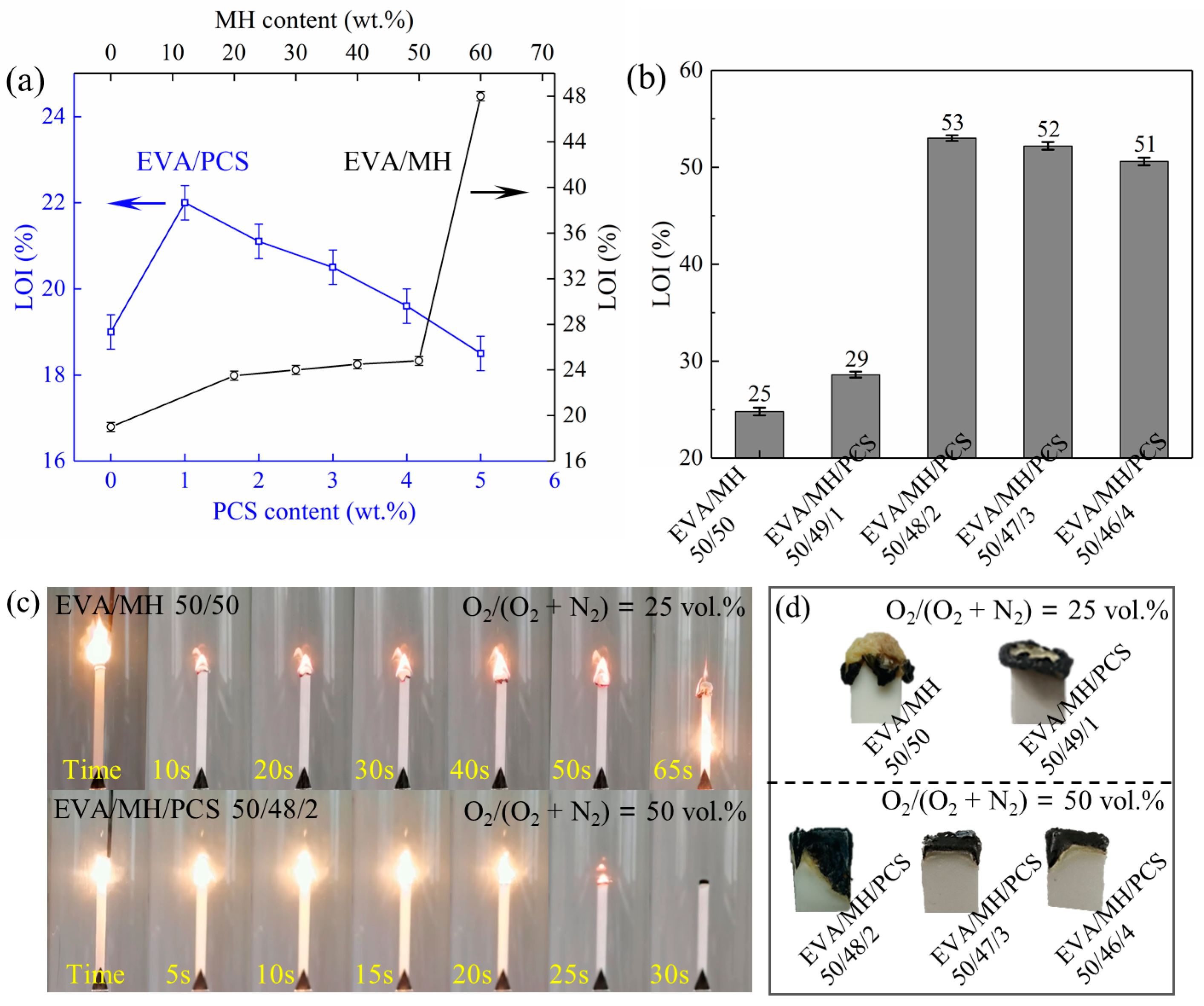
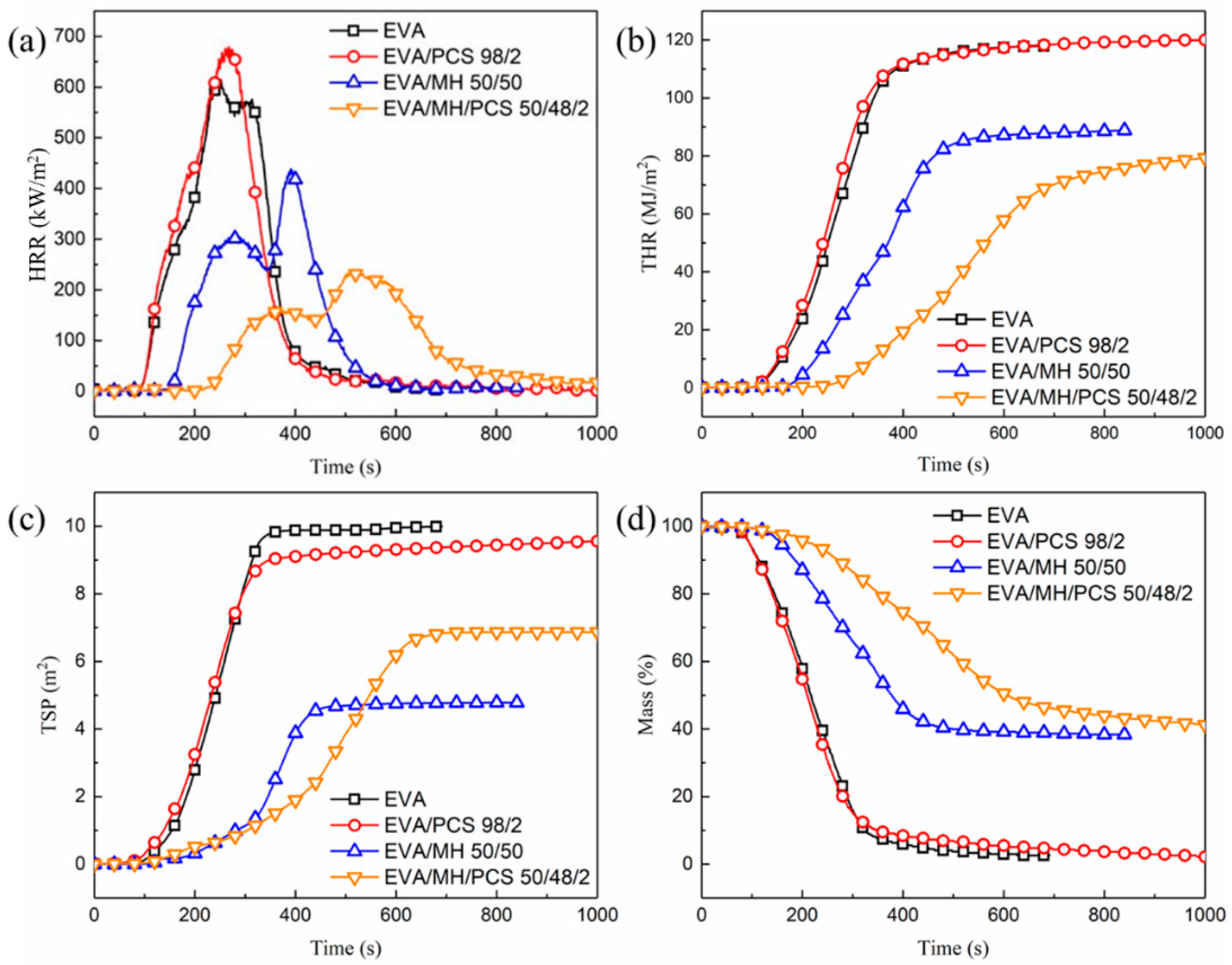
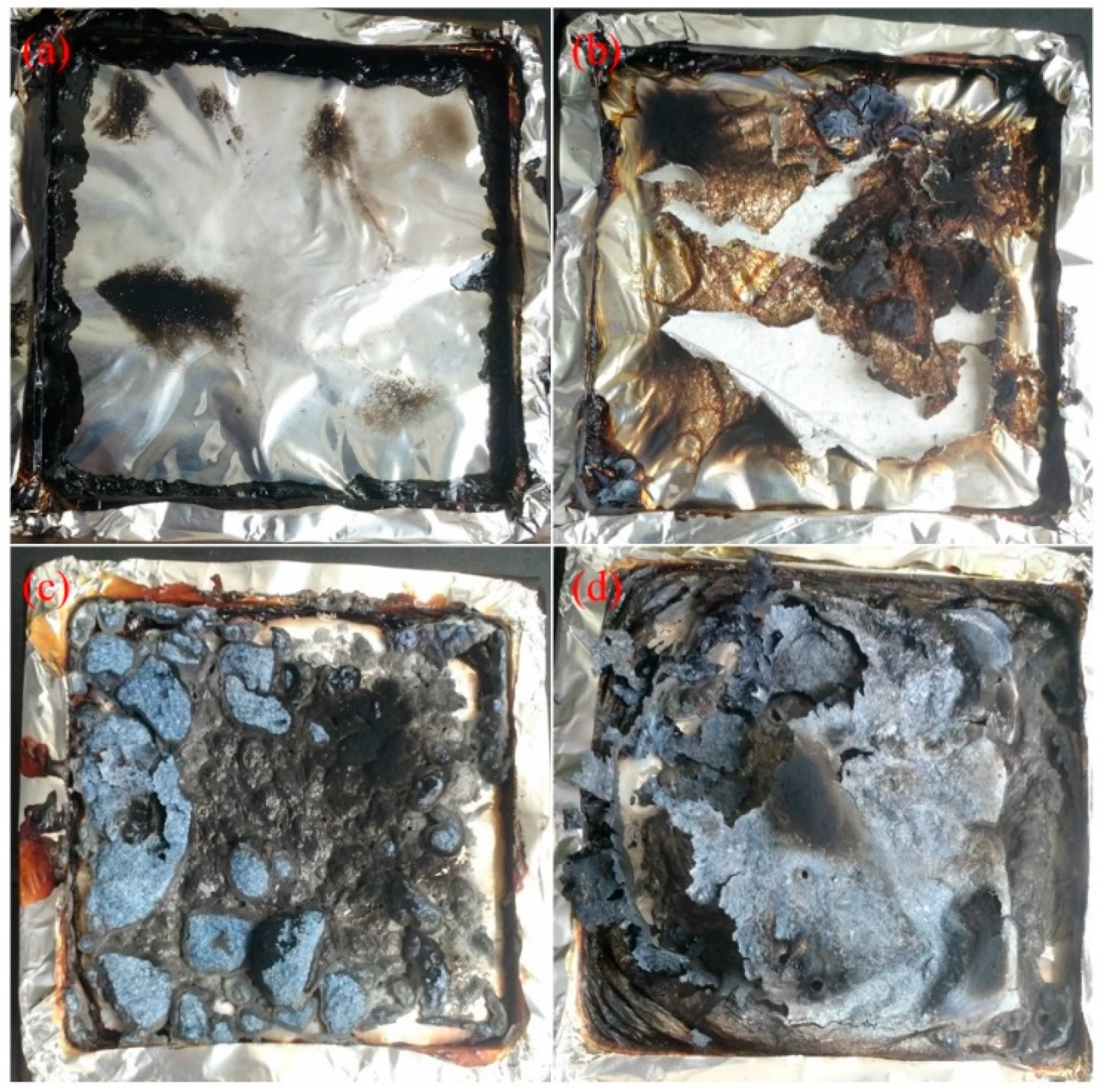
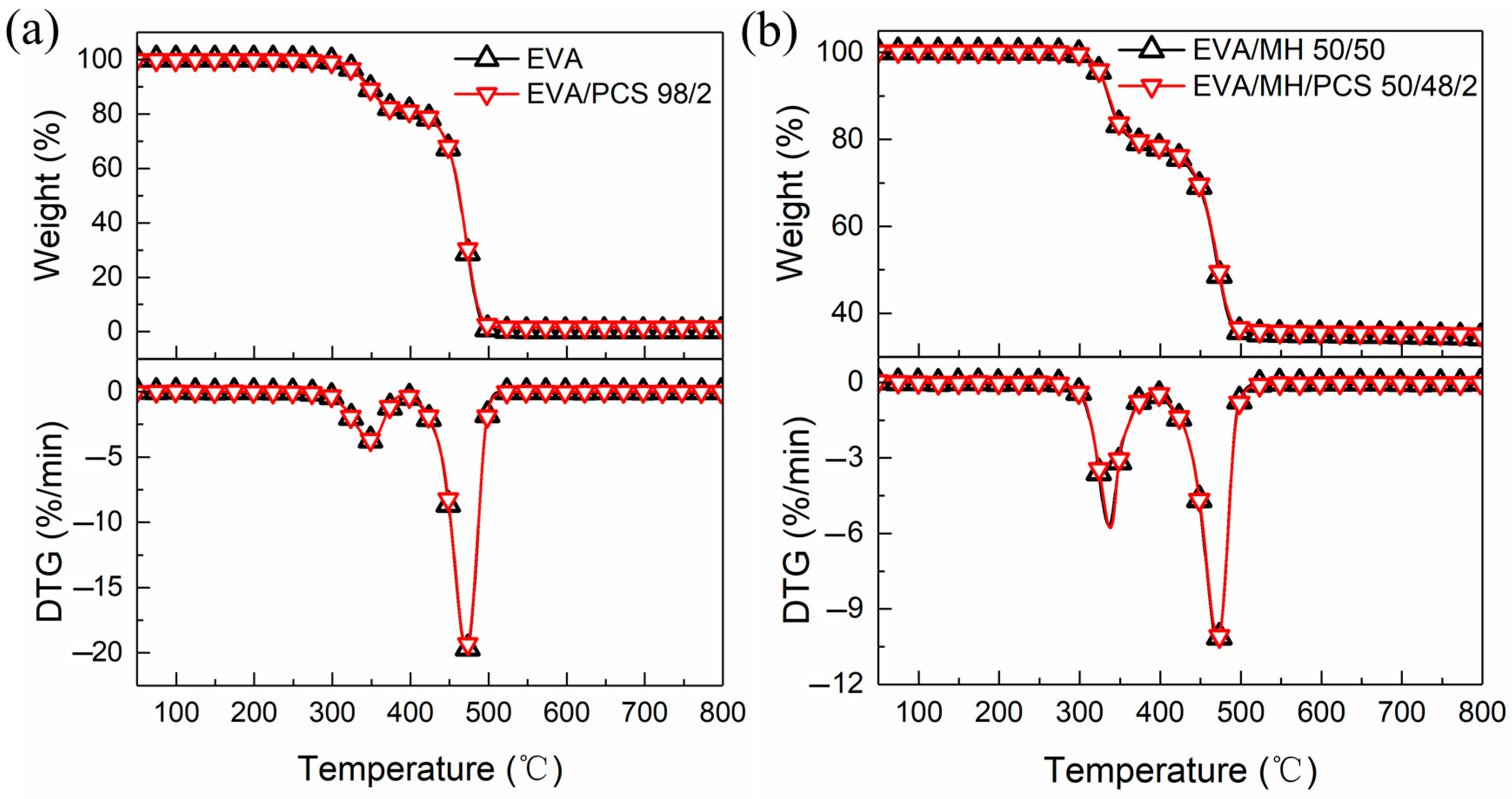
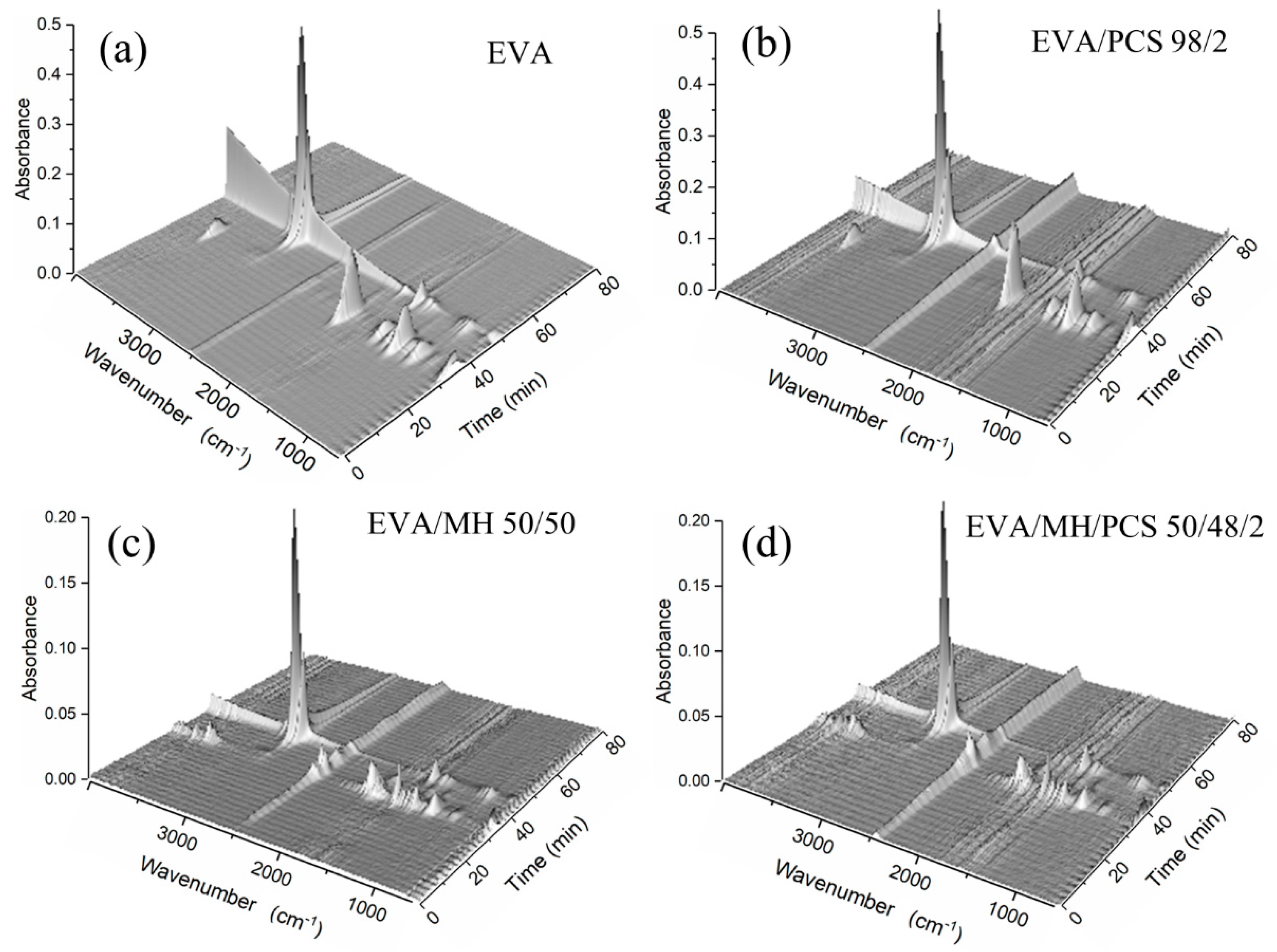

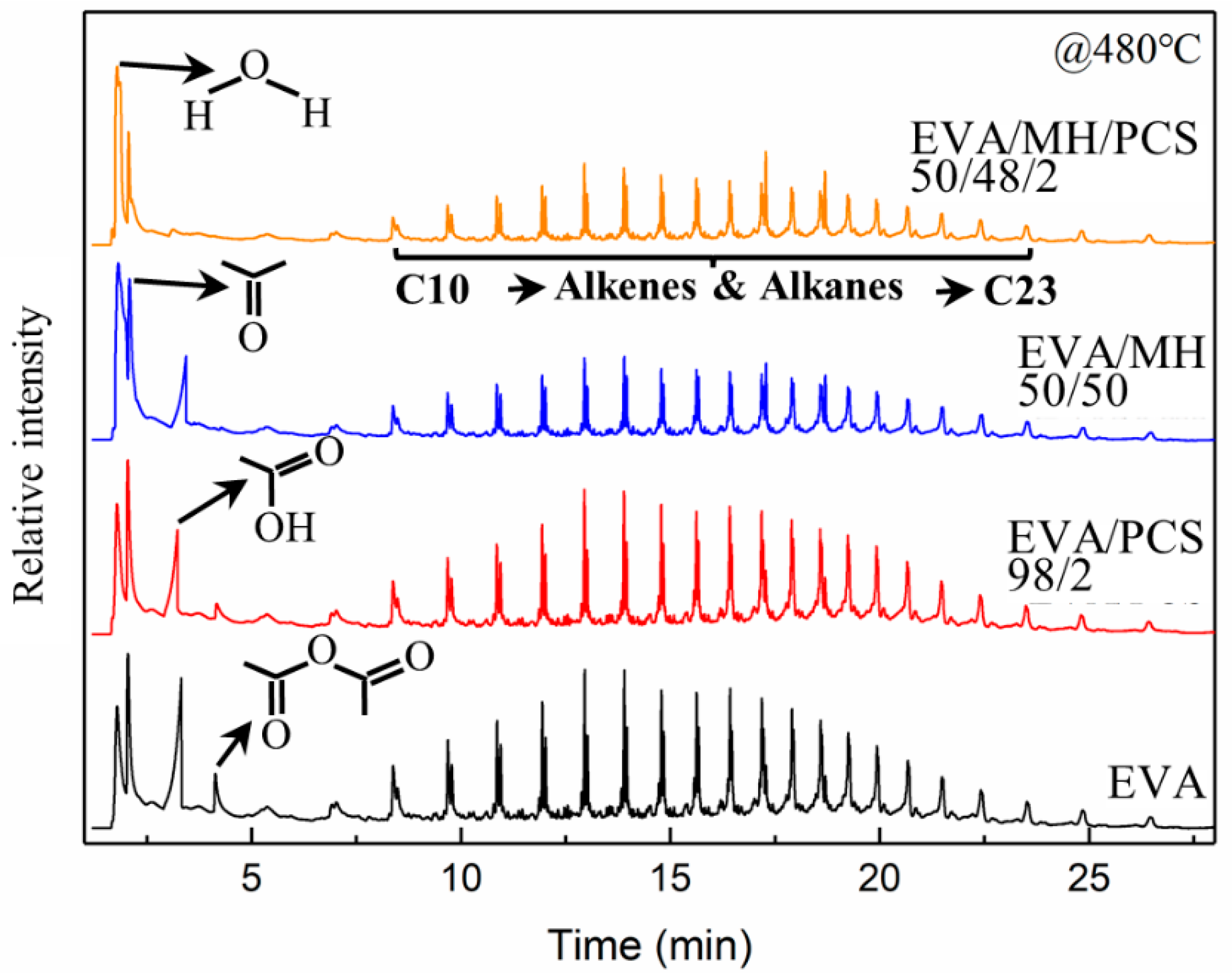

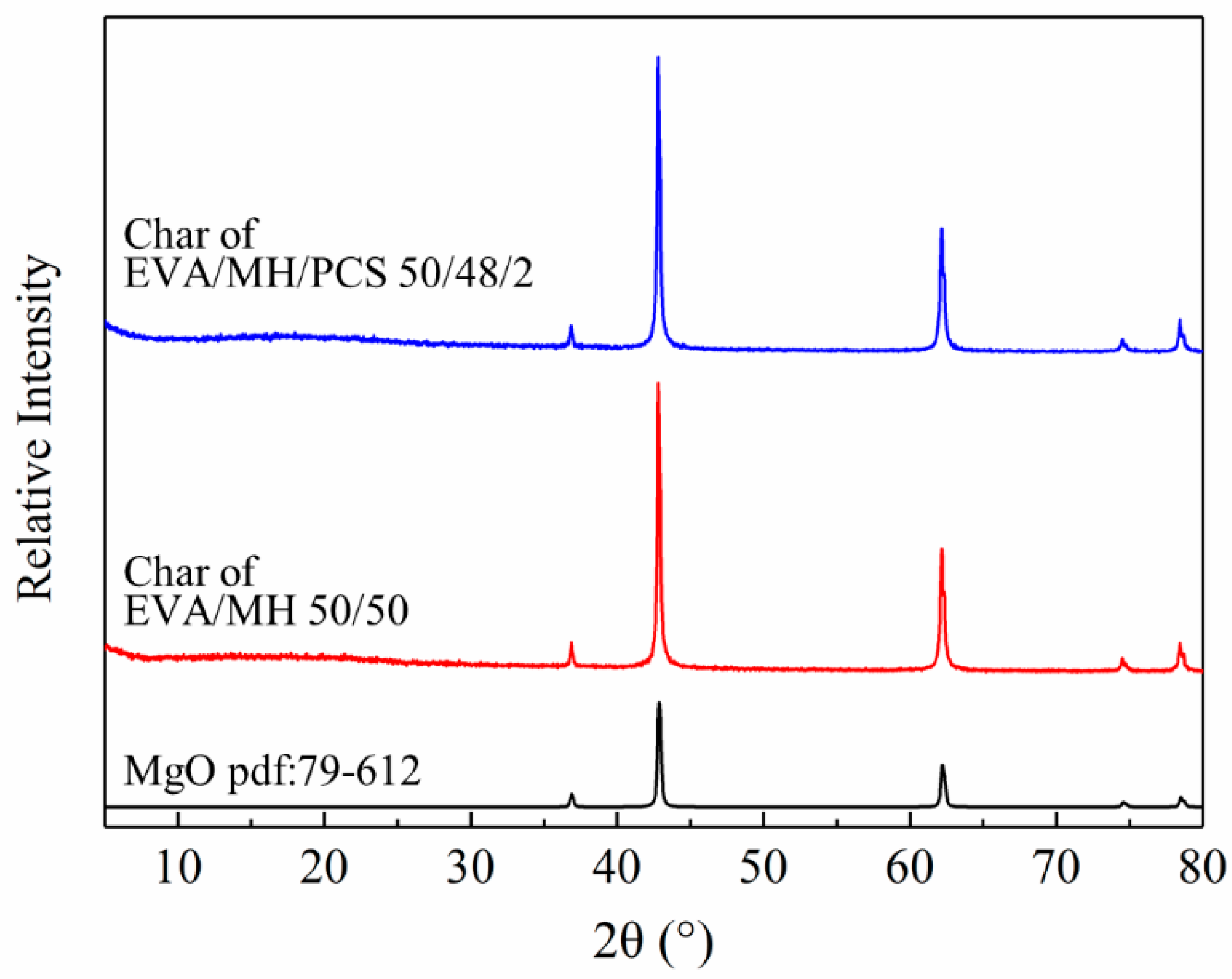
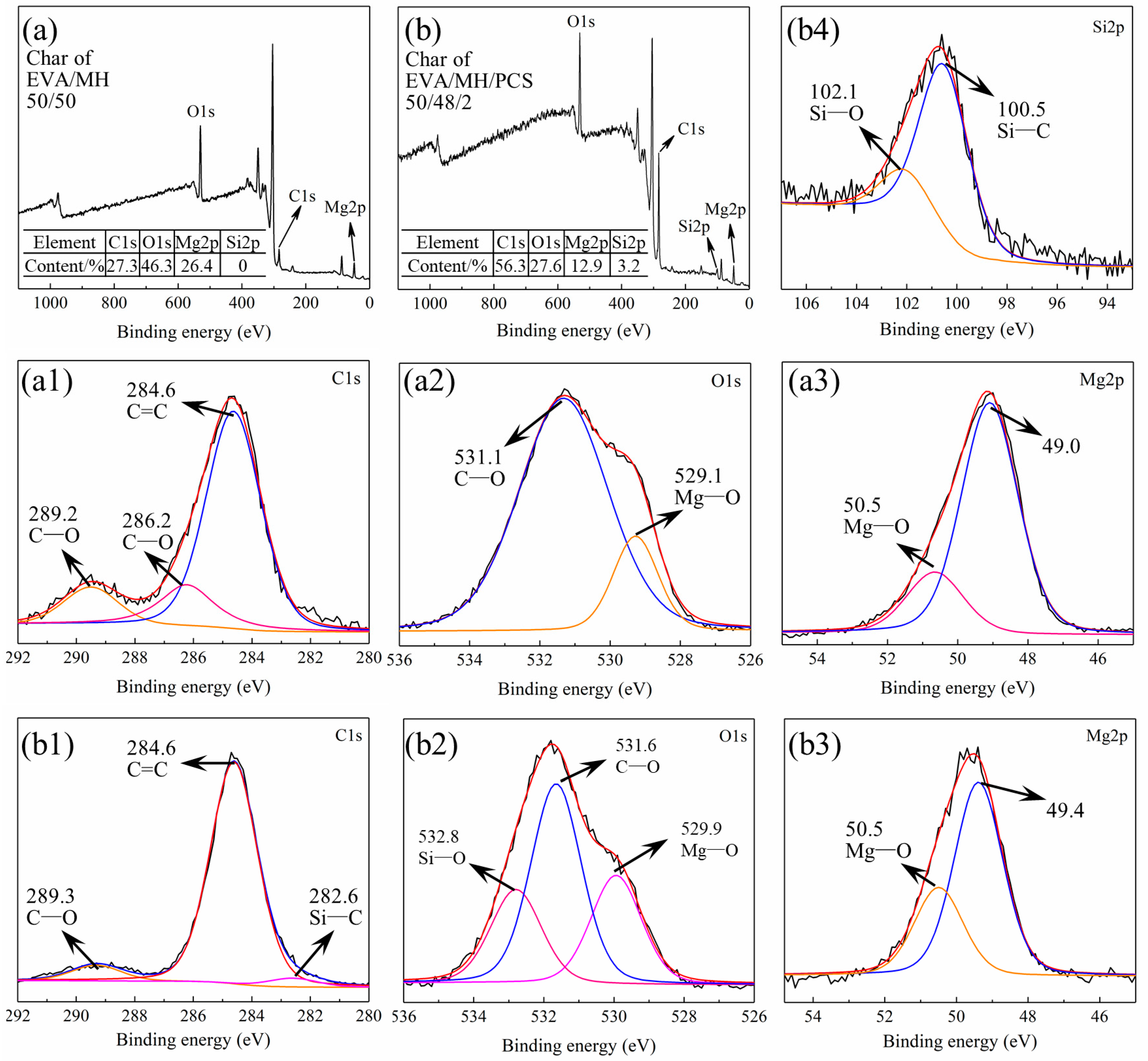
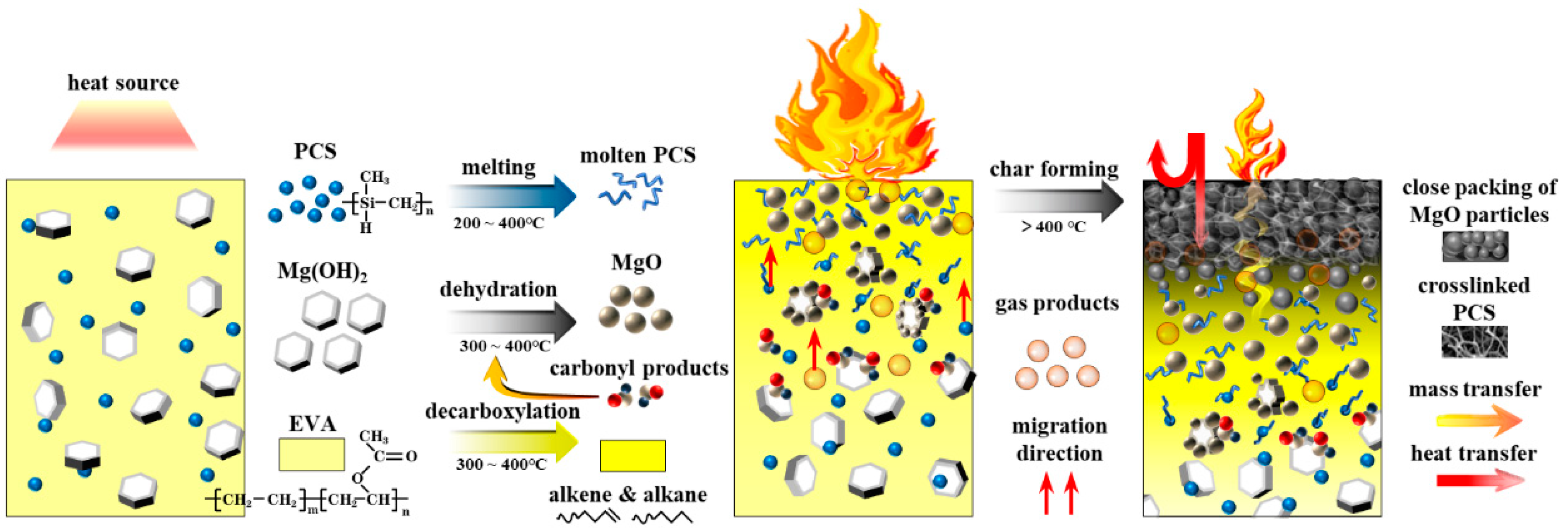
| Sample | EVA | EVA/PCS | EVA/MH | EVA/MH/PCS |
|---|---|---|---|---|
| TTI (s) | 91 | 92 | 149 | 218 |
| tpHRR1 (s) | 153 | 176 | 128 | 146 |
| pHRR1 (kW/m2) | 619 | 678 | 307 | 160 |
| tpHRR2 (s) | -- | -- | 243 | 293 |
| pHRR2 (kW/m2) | -- | -- | 438 | 236 |
| THR (MJ/m²) | 118 | 120 | 88 | 85 |
| TSP (m2) | 10 | 9.5 | 4.7 | 6.8 |
| FPI (s·m2/kW) | 0.15 | 0.14 | 0.34 | 0.92 |
| FGI (kW/(m2·s)) | 2.54 | 2.53 | 1.12 | 0.46 |
| THRI (MJ/m²) | 2.05 | 2.05 | 1.92 | 1.67 |
| TSPI (m2) | 0.75 | 0.69 | 0.32 | 0.03 |
| Sample | T5 (°C) | T10 (°C) | T50 (°C) | Tmax1 (°C) | Tmax2 (°C) | Rmax1 (%/min) | Rmax2 (%/min) | Residue at 600 °C (%) |
|---|---|---|---|---|---|---|---|---|
| EVA | 332 | 347 | 462 | 349 | 471 | −3.6 | −19.7 | 0.3 |
| EVA/PCS 98/2 | 331 | 342 | 463 | 349 | 471 | −3.6 | −19.4 | 1.5 |
| EVA/MH 50/50 | 326 | 335 | 472 | 337 | 470 | −5.6 | −10.3 | 35.1 |
| EVA/MH/PCS 50/48/2 | 326 | 336 | 473 | 338 | 471 | −5.7 | −10.2 | 35.6 |
| Group | Vibration Mode | Wavenumber (cm−1) |
|---|---|---|
| –OH | O–H stretching | 3580 |
| CO2 | C=O stretching | 2360 |
| CH4 | C–H stretching | 3015 |
| –CH2–, –CH3 | C–H asymmetric stretching | 2930 |
| –CH2-, –CH3 | C–H symmetric stretching | 2860 |
| –C=O | stretching | 1798 |
| –CH3 | C–H asymmetric bending | 1509 |
| –CH2- | scissoring | 1460 |
| –C–OH | C–O in-plane bending | 1385 |
| Ar–H | C–O stretching | 1265 |
| –C–OH | C–O stretching | 1175 |
| =CH2 | =C–H out of plane bending | 960–1000 |
Publisher’s Note: MDPI stays neutral with regard to jurisdictional claims in published maps and institutional affiliations. |
© 2021 by the authors. Licensee MDPI, Basel, Switzerland. This article is an open access article distributed under the terms and conditions of the Creative Commons Attribution (CC BY) license (https://creativecommons.org/licenses/by/4.0/).
Share and Cite
Zhang, T.; Wang, C.; Wang, Y.; Qian, L.; Han, Z. Enhanced Flame Retardancy in Ethylene–Vinyl Acetate Copolymer/Magnesium Hydroxide/Polycarbosilane Blends. Polymers 2022, 14, 36. https://doi.org/10.3390/polym14010036
Zhang T, Wang C, Wang Y, Qian L, Han Z. Enhanced Flame Retardancy in Ethylene–Vinyl Acetate Copolymer/Magnesium Hydroxide/Polycarbosilane Blends. Polymers. 2022; 14(1):36. https://doi.org/10.3390/polym14010036
Chicago/Turabian StyleZhang, Tiefeng, Chunfeng Wang, Yongliang Wang, Lijun Qian, and Zhidong Han. 2022. "Enhanced Flame Retardancy in Ethylene–Vinyl Acetate Copolymer/Magnesium Hydroxide/Polycarbosilane Blends" Polymers 14, no. 1: 36. https://doi.org/10.3390/polym14010036







